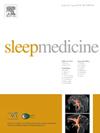Beyond sleep disturbance: Structured analysis of sleep habits, chronotype and sleep disorders in adults with glioma. A cross-sectional exploratory study
IF 3.8
2区 医学
Q1 CLINICAL NEUROLOGY
引用次数: 0
Abstract
Objective
To evaluate the prevalence of the whole spectrum of sleep disorders as well as sleep related motor phenomena and chronotype in adults with glioma and to analyze their link with tumor localization and grade.
Methods
This prospective cross-sectional exploratory study included 79 patients with glioma irrespective of localization and type. Sleep habits, sleep disorders of any kind and chronotype were evaluated in structured interviews using validated disease specific scales.
Results
For the whole sample the PSQI score was not increased, and specific insomnia severity was low. Patients with frontal tumors had worse sleep quality according to the PSQI and were more often allocated to worse ISI categories. The prevalence of EDS was markedly increased (ESS >10 in 17.7 % of patients), and 43 % scored ≥3 on STOPBANG. The predominant chronotype was a moderate morning type (54.4 %). Seven patients fulfilled RLS criteria and 9 fulfilled criteria for probable RBD, a self-report of hypnic jerks and nightmares were most common (45.6 % and 31.6 % respectively). According to regression analyses tumor relapse, depressive symptoms and fatigue determined poor sleep quality (Nagelkerke's R2: 0.511 p < 0.001), while performance-status, fatigue and anti-seizure medication contributed to excessive daytime sleepiness (Nagelkerke's R2: 0.600, p < 0.001), and age, BMI, and tumor localization contributed to the risk of sleep apnea (Nagelkerke's R2: 0.556, p < 0.001).
Conclusions
This study shows the broad range of sleep symptoms in glioma patients, and a complex association with tumor grade and localization. This underlines the need for a comprehensive evaluation of sleep related symptoms in glioma patients.
超越睡眠障碍:神经胶质瘤成人睡眠习惯、睡眠类型和睡眠障碍的结构化分析。横断面探索性研究
目的评价成人神经胶质瘤患者全谱睡眠障碍、睡眠相关运动现象和睡眠时型的患病率,并分析其与肿瘤定位和分级的关系。方法本前瞻性横断面探索性研究纳入79例胶质瘤患者,不论其定位和类型。睡眠习惯、任何类型的睡眠障碍和时间类型在结构化访谈中使用有效的疾病特定量表进行评估。结果全组患者PSQI评分未升高,具体失眠严重程度较低。根据PSQI,额叶肿瘤患者的睡眠质量较差,并且更常被分配到较差的ISI类别。EDS患病率明显增加(17.7%的患者出现ESS >;10), 43%的患者STOPBANG评分≥3分。主要的睡眠类型为中度晨型(54.4%)。7例患者符合RLS标准,9例符合可能的RBD标准,自述睡眠抽搐和噩梦最常见(分别为45.6%和31.6%)。根据回归分析,肿瘤复发、抑郁症状和疲劳是睡眠质量差的决定因素(Nagelkerke’s R2: 0.511 p <;0.001),而表现状态、疲劳和抗癫痫药物会导致白天过度嗜睡(Nagelkerke’s R2: 0.600, p <;0.001),年龄、BMI和肿瘤定位与睡眠呼吸暂停的风险相关(Nagelkerke’s R2: 0.556, p <;0.001)。结论神经胶质瘤患者的睡眠症状范围广泛,且与肿瘤分级和定位有复杂的关系。这强调了对神经胶质瘤患者睡眠相关症状进行全面评估的必要性。
本文章由计算机程序翻译,如有差异,请以英文原文为准。
求助全文
约1分钟内获得全文
求助全文
来源期刊

Sleep medicine
医学-临床神经学
CiteScore
8.40
自引率
6.20%
发文量
1060
审稿时长
49 days
期刊介绍:
Sleep Medicine aims to be a journal no one involved in clinical sleep medicine can do without.
A journal primarily focussing on the human aspects of sleep, integrating the various disciplines that are involved in sleep medicine: neurology, clinical neurophysiology, internal medicine (particularly pulmonology and cardiology), psychology, psychiatry, sleep technology, pediatrics, neurosurgery, otorhinolaryngology, and dentistry.
The journal publishes the following types of articles: Reviews (also intended as a way to bridge the gap between basic sleep research and clinical relevance); Original Research Articles; Full-length articles; Brief communications; Controversies; Case reports; Letters to the Editor; Journal search and commentaries; Book reviews; Meeting announcements; Listing of relevant organisations plus web sites.
 求助内容:
求助内容: 应助结果提醒方式:
应助结果提醒方式:


